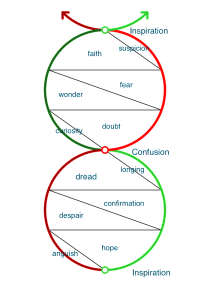Cognitive Emotions
The search for verifiable structures in human development has resulted in significant findings of developmental milestones. At the same time, the perspectives of intuition and spontaneity, due to their anecdotal nature, have been neglected. Double-helix dynamics seeks to integrate the perspectives of verifiable structure and intuition.
For humans, life is permeated with cognitive ambiguity and emotional ambivalence. Dealing with these varying thoughts and feelings challenges our intellectual and emotional maturity. To track these dynamics I found it helps to define what I call “cognitive emotions.”
Most feelings beyond immediate pain and pleasure have intrinsic cognitive features. And most thoughts are not feeling-neutral. While this defines a vast field, we can narrow it down to the cognitive emotions involved in the means we use to understand the world and the self.
From this perspective, the most basic cognitive emotions are “inspiration” and “confusion.” Inspiration draws us into the world by revealing a new way of understanding the world. Primarily this allows us to savor the world in ways we previously could not. As the world is explored through these new means, the limitations of this understanding become increasingly apparent. When these limitations appear pervasive, we are thrown back on ourselves in confusion. Exploring these limitations explicitly helps us develop coping skills to regulate our interactions with the world and prepare us for the next “inspiration.”
These cognitive emotions tie back into the model in the following ways: 1) Inspiration is associated with affirmation, which is represented in the model as the green spiral. I use green for its cultural association with the green traffic signal for “Go!” 2) Confusion is associated with negation, which is represented in the model as the red spiral. I use red for its cultural association with the red traffic signal for “Stop!” Confusion and Inspiration are our developmental stops and goes.
These basic outlines allow us to understand the development and interaction of inspiration and confusion. After we enter a new realm of understanding the world or a new sphere of understanding the self, we come to apply the associated savoring and coping skills more consistently and extensively. This involves lengthening the attention span. For instance, for young children just learning to speak, the one-word utterance virtually comes to them in a flash. But a fuller sentence takes concentration. Thus the difference between “Ball!” and “Mama, gimme ball!”
This lengthening of the attention span serves to diffuse the inspiration on which it is based. Thus, as inspiration explicitly decreases, confusion implicitly increases until it explicitly arrives on the scene. After this, coping skills serve to diffuse the confusion, paving the way for the emergence of the next level of inspiration.
The waxing and waning of inspiration and confusion can be pictured in a double-helix configuration. If we add into the structure the developments of formation, comparison and relation, we can get a good impression of the development of cognitive emotions through the potential life-span.
What I will present next comes with no claims to technical accuracy because there are no established technical terms for what I want to describe. But I have found it helpful to convey an impression of how inspiration and confusion interact and develop.
Here is how they align on the double helix:
I welcome suggestions for this website, and recently got one from Donald T. Saposnek, PhD, who asked me what drives the model. My response was that it is not so much that the model is “pushed” as it is “pulled”: what motivates the person to develop is the joy of discovery, and with it, the promise of things yet discovered. In relation to the person’s orientation of consciousness, this means someone developing is being alert to the possibilities of life (Bruner considers the detection of possibilities to be the main task of teaching and learning, see a recent video of him on this subject when he was 99 years old: link). This dynamic fits with the basic definition of philosophy, the love of wisdom, as originating in curiosity and wonder.
The love of discovery is why I loved becoming part of the intellectual community at Cowell College at UC Santa Cruz in 1975. I soon became a student of Bhuwan Joshi, professor of psychology and religious studies, who crafted the Cowell College motto: The Pursuit of Truth in the Company of Friends.
This website is dedicated in his honor.
To sum it up in a GIF:
As the bright light of consciousness develops, notice how previous developments go from bright green and red to dark green and red, depicting how these previous developments become “tacit” knowledge to our on-going consciousness. For instance, after we learn how to walk, we can walk sub-consciously while we think about what we will do when we arrive at our destination. Rehearsing in the mind takes the focus of consciousness while walking is peripheral (until we stumble, then whack! back to our feet on the ground!).


